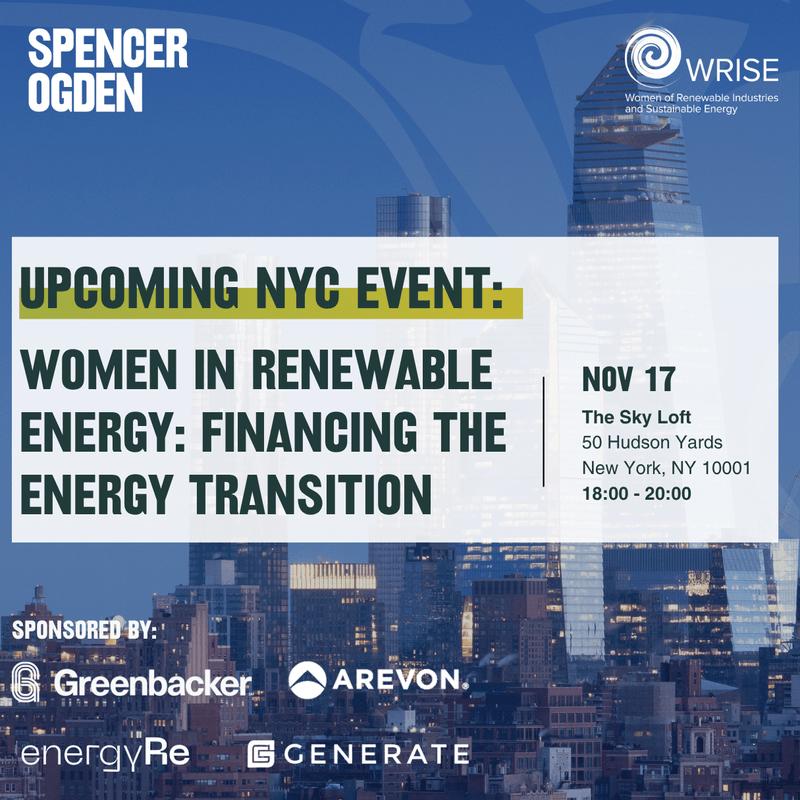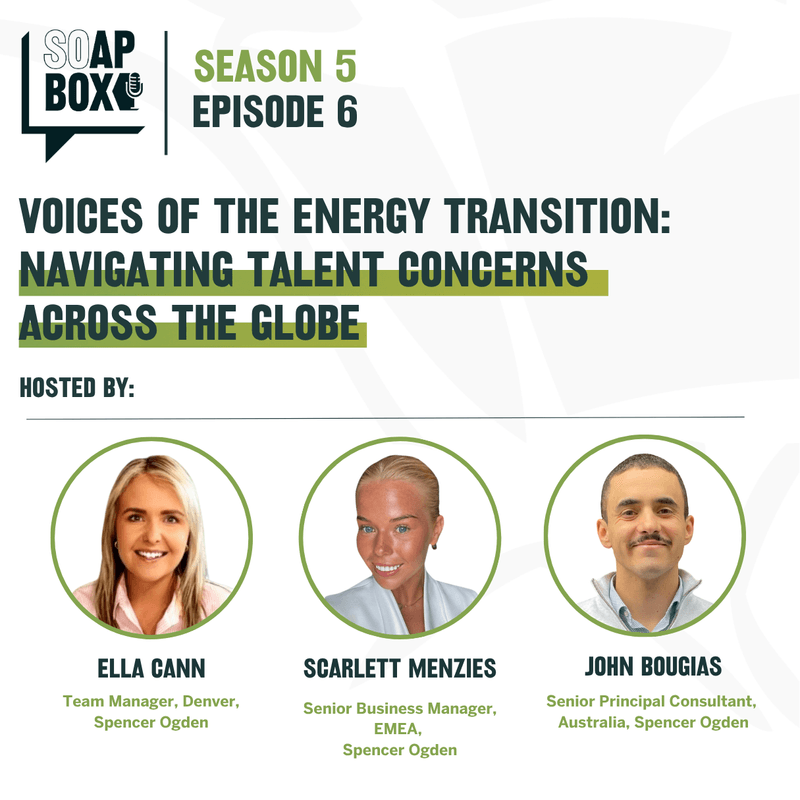Reshaping the Energy Transition: Navigating Change in the US
The re-election of Donald Trump into the White House will cause a ripple effect across the global energy sector. In the recent edition of IMPACT, our LinkedIn newsletter, with Head of External Affairs Rebecca Groundwater from the Energy Industries Council, we are focusing on the opportunities that the new US energy landscape brings for the energy transition. Client Services Director Sean Goldenberg adds an approach from Spencer Ogden, looking at how our clients are navigating the new political landscape and what we are doing to support them.
Where Supply Chain Opportunities Lie in the US Energy Transition
Written by Rebecca Groundwater, Head of External Affairs at the Energy Industries Council (EIC)

The Current US Energy Landscape
Over the past five years or so, energy transition projects have steadily advanced across various technologies, driving consistent year-on-year growth, largely fuelled by the cleantech industries. The mature renewable sector has been primarily led by solar, with a significant number of onshore wind developments also contributing. Other mature renewable sectors, however, have seen fewer project announcements during this period.
In the U.S., nearly 75% of projects under development fall within the cleantech space, with Energy Transition and Renewables dominating the landscape. Oil & Gas accounts for just over 13% of developments, while the Midstream sector represents close to 8% of the projects currently being tracked by the Energy Industries Council (EIC). The growth in renewable projects is overwhelmingly driven by the solar sector, which has maintained a steady stream of project announcements. Many of these projects are now underway across the country and are increasingly being co-located with other renewable developments.
Trending Sectors
There is an estimated $1.18 trillion of CAPEX up to 2030 on the projects that have been announced to date and, should all of the energy transition projects that have been announced proceed, investment in those sectors would exceed $409 billion, with energy storage alone seeing $150 billion of CAPEX. While oil and gas project numbers are relatively low, oil and gas investment is high, with the sectors covered seeing an estimated $338 billion of CAPEX should all projects proceed. This investment is largely driven by the midstream sector and, in particular, the LNG liquefaction sector.
LNG liquefaction stands out as one of the most significant growth markets for our members in terms of future investment. Currently, 28 developments are proposed, and despite the Biden administration’s freeze on LNG export permit approvals, developers have continued proposing new projects. What they haven’t done, however, is make final investment decisions (FID) during this period. That said, a small number of projects are expected to come online between now and 2028, with a larger wave of projects anticipated to enter operation toward the end of the decade, assuming approvals and FIDs are secured.
Rising demand for U.S. gas, particularly from Europe, has been a key driver. Future LNG investments will be fuelled by the anticipated global increase in energy demand. Baseload energy is critical to meeting this demand, and gas is poised to play a central role, especially given the surge in investments in data centre projects.
A Projected Rise in Hydrogen?
Hydrogen in the U.S. is emerging as a promising growth sector. Project announcements have surged year-over-year, driven primarily by green and blue hydrogen production projects. This momentum accelerated following the introduction of the Inflation Reduction Act (IRA) and the 45V clean hydrogen production tax credits, which are disbursed once hydrogen is produced. These incentives have given developers the confidence to invest, and in 2023 alone, 11 projects - with an estimated CAPEX exceeding $10 billion - reached FID. The U.S. is rapidly positioning itself as a global leader in clean hydrogen production, aided by these policies, and unlike other countries with similar ambitions, it is advancing projects to the construction phase. While near-term projects are modest in scale, larger developments are expected to come online toward the latter part of the decade, aligning with projected demand increases.
Carbon Capture & Alternative Fuels
In the CCUS (Carbon Capture, Utilisation, and Storage) sector, there has been a sharp rise in project proposals since the start of the decade, with momentum continuing into 2025, bolstered by the IRA and the 45Q tax credit for carbon sequestration. A clear pipeline of projects exists, with tens of billions of dollars poised for investment. The U.S. has demonstrated leadership in this space, with several projects reaching the critical FID stage, though most remain relatively small-scale. Over 92% of proposed projects are still in the engineering phases, with only a handful under construction.
Alternative fuel projects, much like other Energy Transition sectors, have seen a notable increase in announcements. Biofuels and Sustainable Aviation Fuel (SAF) projects have been the primary drivers of this growth, with a significant number reaching FID. SAF investments, in particular, have been supported by IRA tax credits. The Biden administration has also set a target for 10% of all aviation fuel to come from SAF, and airlines have made ambitious commitments to reduce emissions through SAF adoption.
The International Picture
Globally, the picture is unsettled: offshore wind faces delays or cancellations (as margins remain too slim to be sustainable), while interest in SAF is growing. Hydrogen’s trajectory, however, remains uncertain, both in terms of pace and form.
In the U.S., the outlook is mixed. LNG and SAF are relatively safe bets, while hydrogen’s future is less clear. Carbon capture appears more certain than hydrogen, though uncertainties persist. Policies are well-intentioned, but without tangible execution, our members will pursue business opportunities where they arise. In the Middle East, for instance, significant opportunities remain for our companies, as they deploy multiple technologies in parallel - precisely the approach we’ve advocated for in the UK and elsewhere.
Our supply chain isn’t siloed, and neither should energy policy be - yet it often is. Until this changes, we won’t see the meaningful rollout of projects or the completion of the long-term puzzle needed to provide business certainty and solid plans for growth.
Navigating Change: The US Energy Market Under Trump - Spencer Ogden’s Perspective
Sean Goldenberg, US Client Services Director, comments on his experience of the US energy and infrastructure market thus far under Trump’s administration.

What are the impacts of the new US administration for Spencer Ogden and our clients?
The Trump administration’s deregulation efforts are reshaping the U.S. energy market, favouring fossil fuels while creating uncertainty for renewables. Rolling back environmental rules and reducing federal support for clean energy have slowed the momentum of wind and solar projects. Offshore wind, in particular, faces challenges as federal backing declines, with companies like GE Vernova and Siemens Energy experiencing fewer turbine orders and project delays. Rising interest rates and supply chain issues add further complications.
Meanwhile, oil and gas producers are benefitting from looser regulations, increased drilling activity, and infrastructure expansion. Coal and natural gas are also seeing reduced compliance costs, making them more competitive. However, global investors continue to push for ESG commitments, leaving the long-term future of fossil fuels uncertain.
For utilities and infrastructure companies, deregulation lowers short-term costs but complicates clean energy strategies. Companies like NextEra and Duke Energy must balance regulatory shifts with investor expectations.
For Spencer Ogden, this evolving landscape presents both challenges and opportunities. Clients need the right talent to adapt, and our expertise in both conventional and renewable energy positions us as a key partner in this transition.
How is Spencer Ogden adapting to the new energy landscape in the US?
Spencer Ogden’s role as a sustainability-focused staffing agency extends beyond renewables. The energy transition requires balancing grid reliability with clean energy goals, creating new opportunities. Investment in smart grids, battery storage, and high-voltage transmission lines is driving demand for engineers, project managers, and grid operators. The push for domestic battery manufacturing is also creating jobs in R&D, production, and system integration.
We are able to focus on staffing solutions that support both traditional and renewable energy projects. Our strength lies in connecting clients with specialist talent across the full energy spectrum - helping businesses seize new market opportunities, build resilient teams, and deliver on their ESG commitments.
You can connect with Sean on LinkedIn to discuss more or reach out to him via email at sean.goldenberg@spencer-ogden.com
View the full Q1 2025 edition of IMPACT here. Subscribe to be notified about the next edition and leave your comments. For any additional information about ESG at Spencer Ogden or partnership opportunities, get in touch with Regan Callender our Global ESG Manager.








